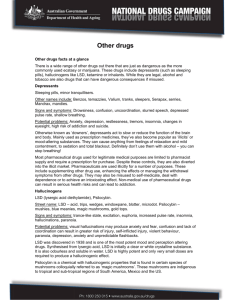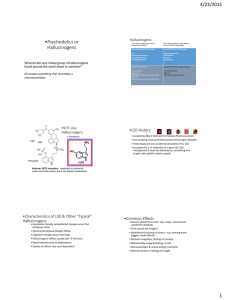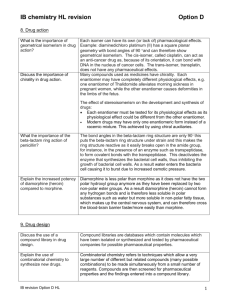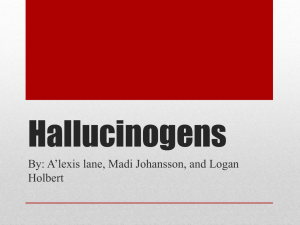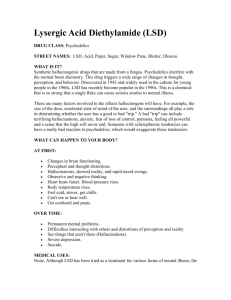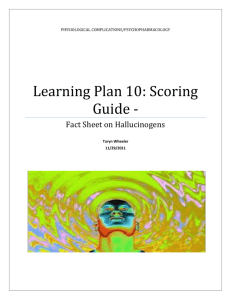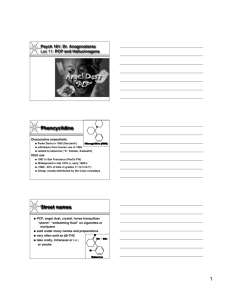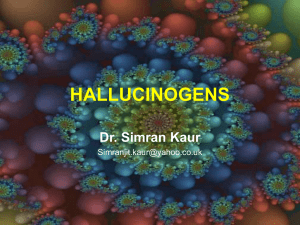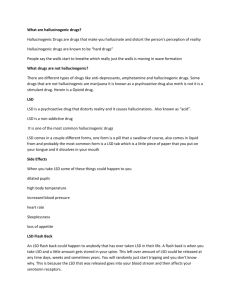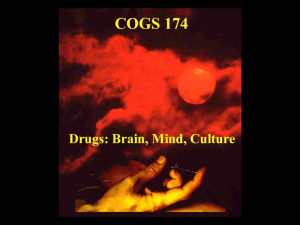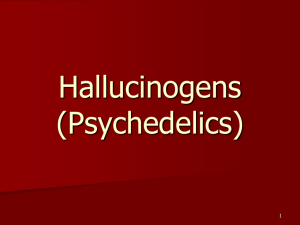hallucinogens-lsd, mescaline, psilocybin,
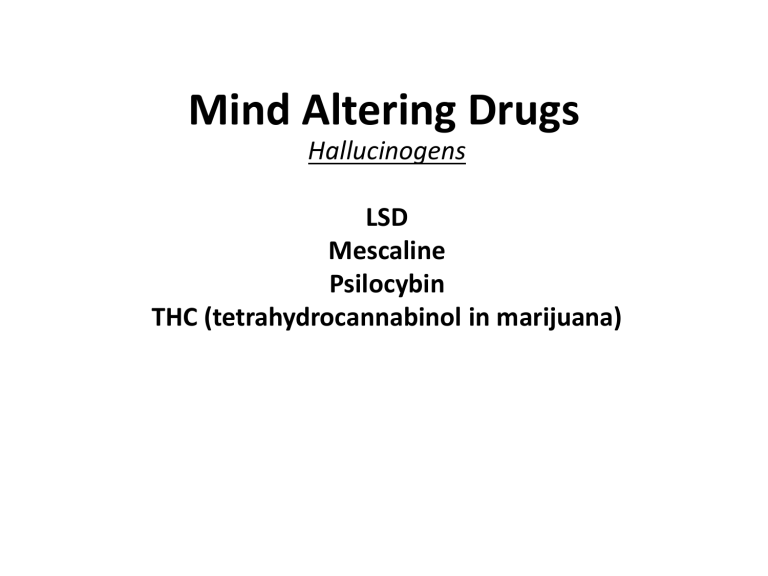
Mind Altering Drugs
Hallucinogens
LSD
Mescaline
Psilocybin
THC (tetrahydrocannabinol in marijuana)
Hallucinogens - LSD, Mescaline, Psilocybin, and
THC (tetrahydrocannabinol in marijuana)
• Hallucinogenic compounds found in some plants and mushrooms (or their extracts) have been used—mostly during religious rituals—for centuries.
• Almost all hallucinogens contain nitrogen
• They are classified as alkaloids.
Hallucinogens - LSD, Mescaline, Psilocybin, and
THC (tetrahydrocannabinol in marijuana)
• Many hallucinogens have chemical structures similar to those of natural neurotransmitters (e.g., acetylcholine-, serotonin etc).
• Research suggests that these drugs work, at least partially, by temporarily interfering with neurotransmitter action or by binding to their receptor sites .
LSD
• LSD (d-lysergic acid diethylamide) is one of the most potent mood-changing chemicals.
• It was discovered in 1938 and is manufactured from lysergic acid, which is found in ergot, a fungus that grows on rye and other grains .
Peyote
• Peyote is a small, spineless cactus in which the principal active ingredient is mescaline.
• This plant has been used by natives in northern
Mexico and the southwestern United States as a part of religious ceremonies.
• Mescaline can also be produced through chemical synthesis.
Psilocybin
• Psilocybin (4-phosphoryloxy-N,Ndimethyltryptamine) is obtained from certain types of mushrooms that are indigenous to tropical and subtropical regions of South America, Mexico, and the United States.
• These mushrooms typically contain less than 0.5 percent psilocybin plus trace amounts of psilocin, another hallucinogenic substance.
LSD and Serotonin
Mescaline and Psilocybin
Effects
• LSD, peyote, psilocybin cause hallucinations, which are profound distortions in a person’s perception of reality.
• Under the influence of hallucinogens, people see images, hear sounds, and feel sensations that seem real but are not.
LSD ; Effects-1
• Powerful hallucinogen
• Effect depends on:
– Dose
– Physiological condition
– Psychological condition
– Expectations
• Magnifies perception
• Destroys sense of judgment
• Produces flashbacks without taking LSD
• Does not produce physical addiction but can produce tolerance and psychological addiction
LSD; Effects-2
• LSD causes dilated pupils;
• can raise body temperature
• increase heart rate and blood pressure;
• can cause profuse sweating, loss of appetite, sleeplessness, dry mouth, and tremors.
Mescaline - Effects
• Produces color hallucinations
• Lasts approximately 12 hours
Psilocybin - Effects
• It can produce muscle relaxation or weakness, ataxia, excessive pupil dilation, nausea, vomiting, and drowsiness.
• Magnified perception
• Low doses produce relaxation, high doses produce effects similar to LSD
Structural similarities
• LSD, mescaline, and psilocybin all contain a benzene ring (6 carbon);
• LSD and psilocybin contain an indole ring (6 carbon benzene ring fused to a 5-membered ring containing a secondary nitrogen)
• LSD is fat-soluble and easily diffuses into the brain
• Psilocybin mimics the structure of the brain hormone serotonin
THC (tetrahydrocannabinol in marijuana)
• Marijuana is the herbal form of cannabis, and comprises the flowers, the subtending leaves, and the stalks of mature, pistillate female plants.
• Hashish is the resinous, concentrated form of cannabis.
• Chemically, the major psychoactive compound in marijuana is delta-9-tetrahydrocannabinol (Δ 9 -THC)
• THC is one of 400 compounds in the plant, including other cannabinoids, such as
– cannabidiol (CBD), cannabinol (CBN), and tetrahydrocannabivarin (THCV),
THC (marijuana)- Effects
• Mild hallucinogen
• Causes silliness and excitement at low doses
• As dosage increases, perception changes and hallucinations result
• Can cause extreme anxiety, depression, uneasiness, panic attack and fearfulness in high doses
• Driving and other tasks requiring thinking are difficult
• Psychological dependence is possible
Legalization Of Cannabis - 1
– cannabis sativa, contains pharmacologically active compounds (cannabinoids)
– Legalization is a hotly contested issue
• Arguments for:
– Relieves symptoms from AIDS,
– Useful for cancer patients (allows for weight gain by suppressing nausea), and
– Treatment of glaucoma (alleviates harmful pressure in the eye)
– Effective in slowing down Alzheimer’s disease
Legalization Of Cannabis -2
• Arguments against:
– Leads to respiratory ailments
– Suppresses immune system
– Decreases fertility
– Causes brain damage and chromosomal damage leading to birth defects
– slowing down motor tasks and resulting in short term memory loss.
– “ Gateway drug ”
– Users of marijuana and other drugs obtain them by illegal sources, leading to a host of crimes (prostitution, theft, murder, etc.)
Legalization Of Cannabis -3
• Historical evidence: legalization of drugs does not always work if it is not thought over and implemented in a manner that will be productive to society.
– For example, opium was legalized in China in the earlier 19th century;
• Result: approximately 90 million addicts, and it took decades to repair the damage.
References
• http://www.drugabuse.gov/publications/infofact s/hallucinogens-lsd-peyote-psilocybin-pcp
• http://www.chemactive.com/ppt/ib/Option_B_-
_Medicine_and_Drugs.ppt
• http://www.chillibreeze.com/articles_various/dru gs.asp
• http://en.wikipedia.org/wiki/Cannabis_%28drug
%29
• http://www.elmhurst.edu/~chm/vchembook/672 hallucin.html
